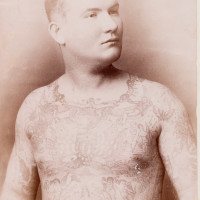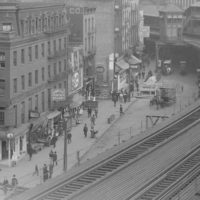
O’Reilly Tattooing with an electric tattoo machine. Ev’ry Month Magazine, Oct 1899. Pg 5. Print.
Samuel F. O’Reilly
Researched & Written by Carmen Nyssen
Born: May 1854, Waterbury, New Haven, CT
Died: April 29, 1909, Brooklyn, Kings, NY
Burial: Cemetery of the Holy Cross, Sec: St. Michaels R:22 Gr:209 Brooklyn, Kings, NY
Learn more about Samuel O’Reilly’s involvement with the invention of the electric tattoo machine on the Early Tinkerers of Electric Tattooing page.
The Young Sam O’Reilly
Samuel O’Reilly was born in Waterbury, New Haven, Connecticut to Irish immigrants Thomas O’Reilly and Mary Ann Hurley in May of 1854. Of five children —himself, Thomas Jr. (b. 1856), Mary Agnes (b. 1859), Maurice Francis (b. 1860), and John (b. 1862) —he was the oldest.
As was typical for the era, O’Reilly entered the workforce at an early age. By the time he was sixteen, he was employed in one of many local clock shops probably specializing in brass productions. Waterbury’s brass industry and the associated clock factories provided work for a good deal of the town’s residents, including O’Reilly’s father.

1870 Jun 5. Federal Census. 4th Ward, Waterbury, New Haven, CT. pg. 95
—
O’Reilly’s Pre-Tattooing Years
Unfortunately, O’Reilly’s course on the working man’s path didn’t last long. From the time he was nineteen, for over a decade, his life was virtually one long streak of lawlessness. His first serious brush with the law was in 1873, when he and two accomplices, Michael Sullivan and Terrance Noonan, burglarized Charles Keasel’s general store. Though O’Reilly was a minor, the resulting punishment was harsh; that July he was sentenced to two years hard labor in the Wethersfield State Prison.
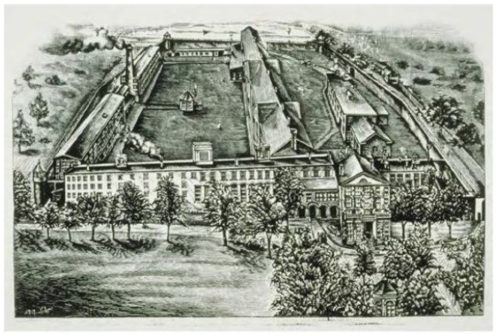
Bird’s-eye view of Wethersfield Prison, Wethersfield, ca. 1880 – Connecticut Historical Society and Connecticut History Online
—
After prison, his digressions continued. On November 29, 1875, he enlisted in the Marine Corps. He served a mere four months with the North Atlantic Squadron before deserting on April 5, 1876 and returning to Waterbury, where he apparently eluded recourse.
An entry in the Waterbury City Directory indicates that O’Reilly briefly conducted business as a “mesmerizer” the next year, but he was in hot water again soon enough. The related incident may explain the root of his lawbreaking habit. In April of 1877, not only O’Reilly, but also his father, mother, and siblings, Thomas and Mary Agnes, robbed the general store of John B. Hopkins in the nearby town of Thomaston. Court documents reveal that bench warrants were issued for each of them and most of the family was taken into custody. Because it was O’Reilly’s second major offense, he escaped arrest by absconding to Detroit, Michigan, where he remained until October of 1878. As reported in a series of newspaper articles, he eventually handed himself over and was escorted back to Connecticut:
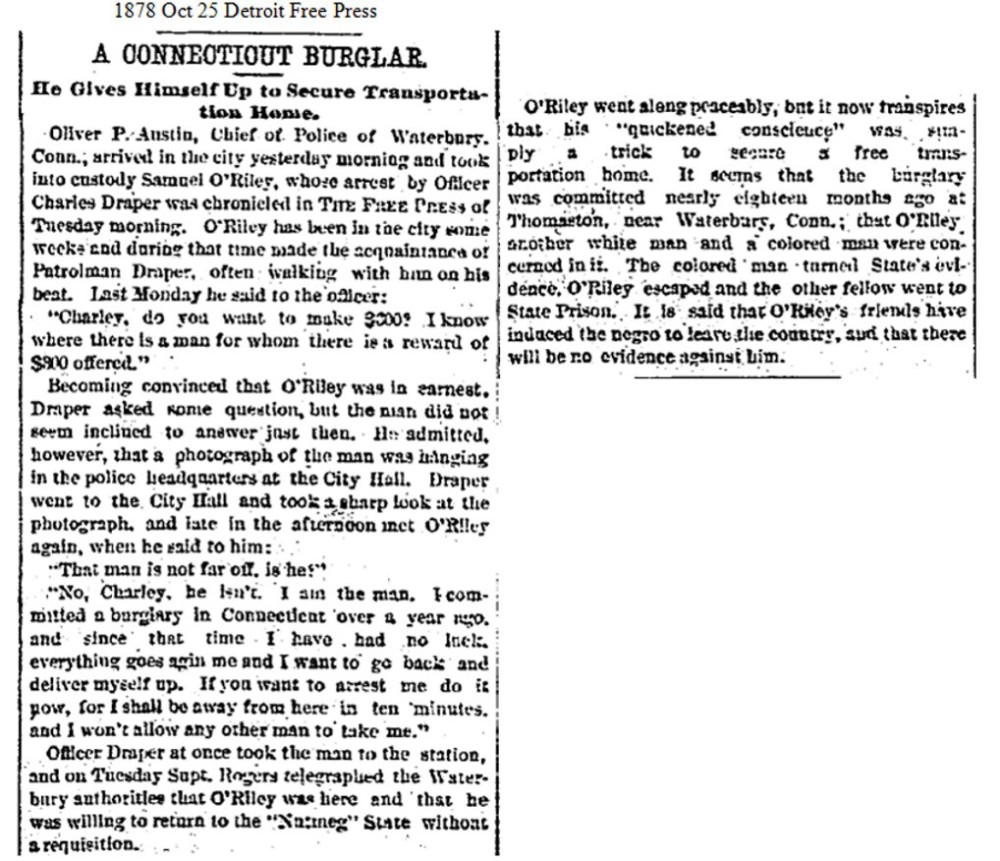
The information in this report about the two accomplices seems to apply to the 1873 case documents rather than the 1878 court documents.
—
Prison Time
Court case records aren’t specific about what happened to O’Reilly’s family, but he was granted no leniency. As anticipated, his prior record was unearthed and submitted as supplemental evidence. The jury found him guilty and he was sentenced another five years in the Wethersfield State Prison. In 1881, around the two year mark, he attempted to shorten his term by persuading the pastor of his church and several townsmen of Thomaston and Waterbury to petition the State for his release. The petition, which pleaded that O’Reilly was “thoroughly and wholly reformed in character and life,” was promptly rejected.
At this point, it’s not clear whether O’Reilly served the full prison sentence, but either way, it’s likely he was rehabilitated in the end. Wethersfield State Prison operated under the rules of a reform institute; prisoners worked all day, returned to their cells at night, and were forbidden from all talking.
Perhaps the strict prison regimen instilled in O’Reilly the discipline required to achieve his one-day flourishing tattoo career. By all evidence, the 1880s period following his discharge marks a turn-around in life and a new beginning—as Prof. Sam O’Reilly, King of the Bowery tattooers.

Block scene showing Sam O’Reilly’s 5 Chatham Square Tattoo Shop. C. 1900. Courtesy Library of Congress. (See below article link)
—
Sam O’Reilly The Tattooer
Exactly when O’Reilly broke into the tattooing profession remains a mystery, as do his whereabouts between 1883 and 1885. It’s possible he resumed working in the brass industry for a short time. In 1886 and 1887, he and brothers, Thomas and John, appear in Brooklyn, New York City directories, listed variously as operator, brasspolisher, and brassfinisher. Thomas apparently stayed in the brass industry; he worked as a clock maker until his death in 1939. (See link at the end of the page for John O’Reilly’s history).
1886 Lain’s Brooklyn City Dir pg. 804
Samuel F. O’Reilly oper. h65 Bond
John F. O’Reilly polisher h65 Bond
Thomas F. O’Reilly h65 Bond
1887 Brooklyn City Dir pg. 875
Samuel F. O’Reilly h82 Bond
John O’Reilly brassfinisher h82 Bond
Thomas F. O’Reilly brasspolisher h82 Bond
As for Samuel, sometime within the first half of the 1880s decade, he left his shadowy past behind and set his mind to learning the tried-and-true art of India ink, Chinese vermillion, and hand needles. By the decade’s end, he had made his name in tattooing. According to tattoo lore, Sam O’Reilly had studied tattooing under “Old Martin” Hildebrandt, one of New York’s first professional tattoo artists, who created some of the earliest trade-specific tattooed attractions. Though definitive documentation hasn’t surfaced yet, a February 1, 1898 New York Evening Post article seems to identify O’Reilly and strongly infers that Hildebrandt was indeed his mentor:
“The third professor is a sometime pupil of Old Martin … He is a shrewd matter of fact fellow, wears glittering rings and carries a gold watch, and is living witness to Old Martin’s genius. He has a stand in a Bowery museum, advertises an experience of sixteen years, and lays claim to national reputation. Whatever his skill may be, the Bowery readily admits that he is “handy with the needles” and, on occasion when “handles” and “full-rigged ships” have been filled and emptied, that he runs “Old Martin” close—than which there is no fuller recognition.”
(Note: The years of experience in the above snippet indicates O’Reilly started tattooing in 1882. At this point, there isn’t enough evidence to verify this claim).
Sam O’Reilly’s Tattooed Attractions
Like his mentor Old Martin, O’Reilly had tattooed several top attractions early in his career. An 1888 New Rochelle newspaper article ceremoniously addressing him as “Prof. S. O’Reilly” reported that he had already covered a total of 12 tattooed ladies, including the famed Mrs. Emma DeBurgh who was then exhibiting in London.
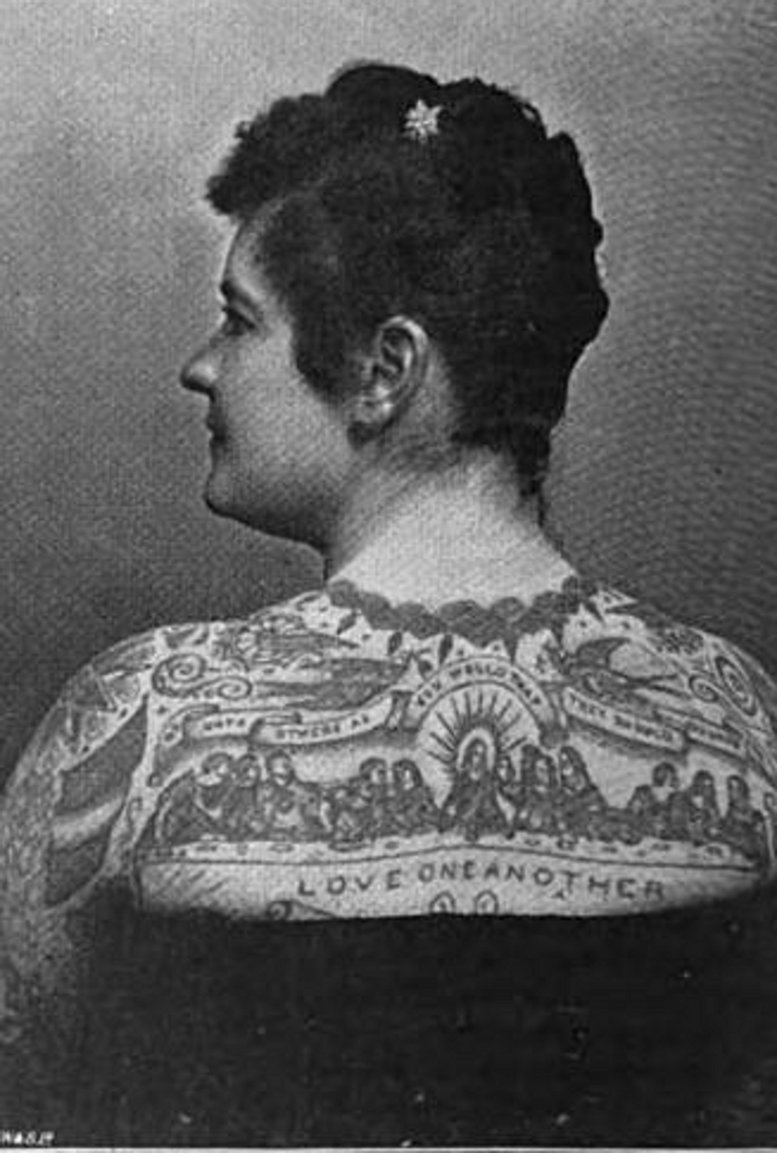
Emma DeBurgh. Bolton, Gambier. Pictures on the Human Skin. The Strand Magazine. 1897. pg. 431. Print.
—
Mrs. DeBurgh likewise confirmed O’Reilly as the person behind her tattoos:

1890 Jan 18 The Era (London) pg. 21
—

Thomas James Reeves, nephew of tattoo artist Sam O’Reilly. Naval Historical Center Online Library, Photo #: NH 101649
In just a short time, by the turn of the 1890s decade, O’Reilly made a sensation in dime museums by presenting the first electrically tattooed attractions: Tom Sidonia, George Karlavagn, and George Mellivan, who each went on to have exciting careers of their own. It’s also possible that he partially electrically tattooed his younger brother John O’Reilly, a tattooed man on the dime museum circuit (see link at end of page).
O’Reilly Family Notes:
As an interesting aside, Sam O’Reilly’s nephew Thomas James Reeves (1895-1941), son of his sister Mary Agnes (O’Reilly) Reeves, was killed in action during the attack on Pearl Harbor, December 7, 1941, and was posthumously awarded the Congressional Medal of Honor. He is buried in the National Memorial Cemetery of the Pacific, in the same cemetery as Sailor Jerry Collins. When O’Reilly and his brothers left for New York, Mary stayed behind and raised her children in and around Thomaston, CT. Thomas Reeves is memorialized there as a local hero, including having a Little League baseball field named for him.
Thomas J. Reeves: A local hero remembered, by David Hutter, 2009
More groundbreaking articles about Prof. Sam O’Reilly’s illustrious tattoo career:
Websites/publications/exhibits citing Carmen Nyssen’s Samuel F. O’Reilly tattoo history research:
TTT: Tattoo. By Maxime Buschi & Nicholas Schonberger. September 25, 2018. Full feature article in book: Ever-Evolving Tattoo Machines by Carmen Forquer Nyssen pg. 496-499
O’Reilly’s Tattoo Machine: April-May 2016 Issue of Irish America Magazine
Wikipedia: Samuel O’Reilly Biography
Tattoodo: Samuel O’Reilly’s Peculiar Reciprocating Electromotored Tattoo Machine
Irish Times, October 16, 2018.
Old-School Ink: New Haven’s Tattoos. New Haven Museum. Lender & Research.
September 23, 2017-March 10, 2018.
See Also: OLD-SCHOOL INK: NEW HAVEN’S TATTOOS EXHIBIT – OPENING SEPT 23 AT NEW HAVEN MUSEUM
Tattooed New York, New York Historical Society, Jan 2017 – April 2017


